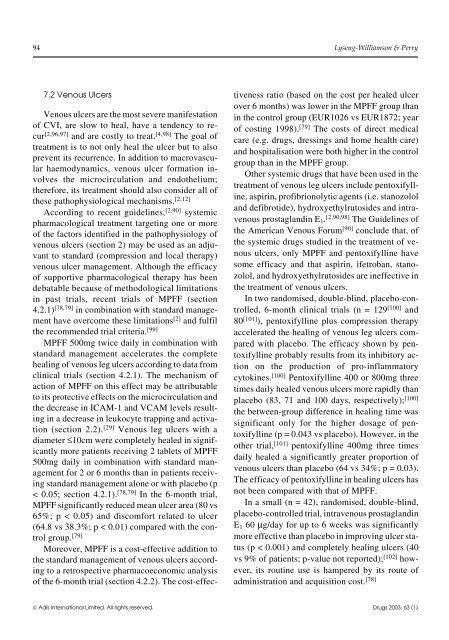Micronised Purified Flavonoid Fraction - QUONIA
Micronised Purified Flavonoid Fraction - QUONIA
Micronised Purified Flavonoid Fraction - QUONIA
Create successful ePaper yourself
Turn your PDF publications into a flip-book with our unique Google optimized e-Paper software.
94 Lyseng-Williamson & Perry<br />
7.2 Venous Ulcers<br />
Venous ulcers are the most severe manifestation<br />
of CVI, are slow to heal, have a tendency to recur<br />
[2,96,97] and are costly to treat. [4,98] The goal of<br />
treatment is to not only heal the ulcer but to also<br />
prevent its recurrence. In addition to macrovascular<br />
haemodynamics, venous ulcer formation involves<br />
the microcirculation and endothelium;<br />
therefore, its treatment should also consider all of<br />
these pathophysiological mechanisms. [2,12]<br />
According to recent guidelines, [2,90] systemic<br />
pharmacological treatment targeting one or more<br />
of the factors identified in the pathophysiology of<br />
venous ulcers (section 2) may be used as an adjuvant<br />
to standard (compression and local therapy)<br />
venous ulcer management. Although the efficacy<br />
of supportive pharmacological therapy has been<br />
debatable because of methodological limitations<br />
in past trials, recent trials of MPFF (section<br />
4.2.1) [78,79] in combination with standard management<br />
have overcome these limitations [2] and fulfil<br />
the recommended trial criteria. [99]<br />
MPFF 500mg twice daily in combination with<br />
standard management accelerates the complete<br />
healing of venous leg ulcers according to data from<br />
clinical trials (section 4.2.1). The mechanism of<br />
action of MPFF on this effect may be attributable<br />
to its protective effects on the microcirculation and<br />
the decrease in ICAM-1 and VCAM levels resulting<br />
in a decrease in leukocyte trapping and activation<br />
(section 2.2). [29] Venous leg ulcers with a<br />
diameter ≤10cm were completely healed in significantly<br />
more patients receiving 2 tablets of MPFF<br />
500mg daily in combination with standard management<br />
for 2 or 6 months than in patients receiving<br />
standard management alone or with placebo (p<br />
< 0.05; section 4.2.1). [78,79] In the 6-month trial,<br />
MPFF significantly reduced mean ulcer area (80 vs<br />
65%; p < 0.05) and discomfort related to ulcer<br />
(64.8 vs 38.3%; p < 0.01) compared with the control<br />
group. [79]<br />
Moreover, MPFF is a cost-effective addition to<br />
the standard management of venous ulcers according<br />
to a retrospective pharmacoeconomic analysis<br />
of the 6-month trial (section 4.2.2). The cost-effec-<br />
tiveness ratio (based on the cost per healed ulcer<br />
over 6 months) was lower in the MPFF group than<br />
in the control group (EUR1026 vs EUR1872; year<br />
of costing 1998). [79] The costs of direct medical<br />
care (e.g. drugs, dressings and home health care)<br />
and hospitalisation were both higher in the control<br />
group than in the MPFF group.<br />
Other systemic drugs that have been used in the<br />
treatment of venous leg ulcers include pentoxifylline,<br />
aspirin, profibrionolytic agents (i.e. stanozolol<br />
and defibrotide), hydroxyethylrutosides and intravenous<br />
prostaglandin E1. [2,90,98] The Guidelines of<br />
the American Venous Forum [90] conclude that, of<br />
the systemic drugs studied in the treatment of venous<br />
ulcers, only MPFF and pentoxifylline have<br />
some efficacy and that aspirin, ifetroban, stanozolol,<br />
and hydroxyethylrutosides are ineffective in<br />
the treatment of venous ulcers.<br />
In two randomised, double-blind, placebo-controlled,<br />
6-month clinical trials (n = 129 [100] and<br />
80 [101] ), pentoxifylline plus compression therapy<br />
accelerated the healing of venous leg ulcers compared<br />
with placebo. The efficacy shown by pentoxifylline<br />
probably results from its inhibitory action<br />
on the production of pro-inflammatory<br />
cytokines. [100] Pentoxifylline 400 or 800mg three<br />
times daily healed venous ulcers more rapidly than<br />
placebo (83, 71 and 100 days, respectively); [100]<br />
the between-group difference in healing time was<br />
significant only for the higher dosage of pentoxifylline<br />
(p = 0.043 vs placebo). However, in the<br />
other trial, [101] pentoxifylline 400mg three times<br />
daily healed a significantly greater proportion of<br />
venous ulcers than placebo (64 vs 34%; p = 0.03).<br />
The efficacy of pentoxifylline in healing ulcers has<br />
not been compared with that of MPFF.<br />
In a small (n = 42), randomised, double-blind,<br />
placebo-controlled trial, intravenous prostaglandin<br />
E1 60 µg/day for up to 6 weeks was significantly<br />
more effective than placebo in improving ulcer status<br />
(p < 0.001) and completely healing ulcers (40<br />
vs 9% of patients; p-value not reported); [102] however,<br />
its routine use is hampered by its route of<br />
administration and acquisition cost. [78]<br />
© Adis International Limited. All rights reserved. Drugs 2003; 63 (1)


